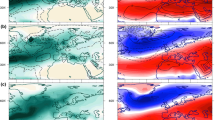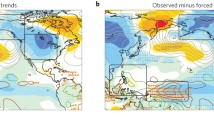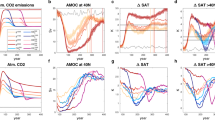Abstract
We discuss climate impacts of a hypothetical shutdown of the thermohaline circulation (‘THC’) in the 2050s, using the climate model HadCM3. Previous studies have generally focussed on the effects on pre-industrial climate. Here we take into account increased greenhouse gas concentrations according to an IS92a emissions scenario. THC shutdown causes cooling of the Northern Hemisphere of -1.7˚C, locally stronger. Over western Europe cooling is strong enough for a return to pre-industrial conditions and a significant increase in the occurrence of frost and snow cover. Global warming restricts the increase in sea ice cover after THC shutdown. This lessens the amount of cooling over NW Europe, but increases it over North America, compared to pre-industrial shutdown. This reflects a non-linearity in the local temperature response to THC shutdown. Precipitation change after THC shutdown is generally opposite to that caused by global warming, except in western and southern Europe, where summer drying is enhanced, and in Central America and southeast Asia, where precipitation is also further reduced. Local rise in sea level after THC shutdown can be large along Atlantic coasts (pm; 25,cm), which would add to the rise caused by global warming. Potentially rapid THC shutdown adds to the range of uncertainty of projected future climate change.
Similar content being viewed by others
References
Allen MR, Ingram WJ (2002) Constraints on future changes in climate and the hydrologic cycle. Nature 419:224–232
Church JA, Gregory JM, Huybrechts P, Kuhn M, Lambeck K, Nhuan MT, Qin D, Woodworth PL (2001) Changes in sea level. In: Houghton JT, Ding Y, Griggs DJ, Noguer M, van~der Linden P, Dai X, Maskell K, Johnson CI (eds) Climate change 2001: The scientific basis. Contribution of Working Group I to the Third Assessment Report of the Intergovernmental Panel on Climate Change. Cambridge University Press, pp. 639–693
Cox PM, Betts RA, Bunton CB, Essery RLH, Rowntree PR, Smith J (1999) The impact of new land surface physics on the GCM simulation of climate and climate sensitivity. Clim Dyn 15:183–203
Cubasch U, Meehl GA, Boer GJ, Stouffer RJ, Dix M, Noda A, Senior CA, Raper SCB, Yap KS (2001) Projections of future climate change. In: Houghton JT, Ding Y, Griggs DJ, Noguer M, van~der Linden P, Dai X, Maskell K, Johnson CI (eds) Climate change 2001: The scientific basis. Contribution of Working Group I to the Third Assessment Report of the Intergovernmental Panel on Climate Change. Cambridge University Press, pp. 525–582
Curry R, Mauritzen C (2005) Dilution of the northern North Atlantic ocean in recent decades. Science 308:1772–1774
Dixon KW, Delworth TL, Spelman MJ, Stouffer RJ (1999) The influence of transient surface fluxes on North Atlantic overturning in a coupled GCM climate change experiment. Geophys Res Lett 26(17):2749–2752
Ganachaud A, Wunsch C (2000) The oceanic meridional overturning circulation, mixing, bottom water formation, and heat transport. Nature 408:453–457
Gordon C, Cooper C, Senior CA, Banks H, Gregory JM, Johns TC, Mitchell JFB, Wood RA (2000) The Simulation of SST, sea ice extents and ocean heat transports in a version of the Hadley Centre coupled model without flux adjustments. Clim Dyn 16:147–168
Gregory JM (1993) Sea level changes under increasing atmospheric CO2 in a transient coupled ocean–atmosphere GCM experiment. J Climate 6:2247–2262
Gregory JM, Dixon KW, Stouffer RJ, Weaver AJ, Driesschaert E, Eby M, Fichefet T, Hasumi H, Hu A, Jungclaus JH, Kamenkovich IV, Levermann A, Montoya M, Murakami S, Nawrath S, Oka A, Sokolov AP, Thorpe RB (2005) A model intercomparison of changes in the Atlantic thermohaline circulation in response to increasing atmospheric CO2 concentration. Geophys Res Lett 32:L12703
Gregory JM, Lowe JA (2000) Predictions of global and regional sea-level rise using AOGCMs with and without flux adjustment. Geophys Res Lett 27:3069–3072
Gregory JM, Oerlemans J (1998) Simulated future sea-level rise due to glacier melt based on regionally and seasonally resolved temperature changes. Nature 391:474–476
Gregory JM, Saenko OA, Weaver AJ (2003) The role of the Atlantic freshwater balance in the hysteresis of the meridional overturning circulation. Clim Dyn 21:707–717
Hulme M (2003) Abrupt climate change: can society cope? Philos Trans R Soc London 361:2001–2021
Jacob D, Goettel H, Jungclaus J, Muskulus M, Podzun R, Marotzke J (2005) Slowdown of the thermohaline circulation causes enhanced maritime climate influence and snow cover over Europe. Geophys Res Lett 32, doi:10.1029/2005GL023831
Johns TC, Gregory JM, Ingram WJ, Johnson CE, Jones A, Lowe JA, Mitchell JFB, Roberts DL, Sexton DMH, Stevenson DS, Tett SFB, Woodage MJ (2003) Anthropogenic climate change for 1860 to 2100 simulated with the HadCM3 model under updated emissions scenarios. Clim Dyn 20:583–612
Knutti R, Stocker TF (2000) Influence of the thermohaline circulation on projected sea level rise. J Climate 13:1997–2001
Latif M, Roeckner E, Mikolajewicz U, Voss R (2000) Tropical Stabilisation of the thermohaline circulation in a greenhouse warming simulation. J Climate 13:1809–1813
Levermann A, Griesel A, Hofmann M, Montoya M, Rahmstorf S (2005) Dynamic sea level changes following changes in the thermohaline circulation. Clim Dyn 24:347–354
Manabe S, Stouffer RJ (1999) The role of the thermohaline circulation in climate. Tellus 51:91–109
Marsh R, Yool A, Lenton TM, Gulamali MY, Edwards NR, Shepherd JG, Krznaric M, Newhouse S, Cox SJ (2004) Bistability of the thermohaline circulation identified through comprehensive 2-parameter sweeps of an efficient climate model. Clim Dyn 23:761–777
McInerney D, Keller K (2007) What are reliable risk-reduction strategies in the face of uncertain climate thresholds? Climatic Change, DOI 10.1007/s10584-006-9137-z, this issue
Mikolajewicz U, Voss R (2000) The role of the individual air-sea flux components in CO2-induced changes of the ocean's circulation and climate. Clim Dyn 16:627–642
Murphy JM, Sexton DMH, Barnett DN, Jones GS, Webb MJ, Collins M, Stainforth DA (2004) Quantification of modelling uncertainties in a large ensemble of climate change simulations. Nature 430:768–772
Parker DE, Legg TP, Folland CK (1992) A new daily Central England Temperature series. Int J Climatol 12:317–342
Pope VD, Gallani ML, Rowntree PR, Stratton RA (2000) The impact of new physical parametrizations in the Hadley Centre climate model–-HadAM3. Clim Dyn 16:123–146
Rahmstorf S (1996) On the freshwater forcing and transport of the Atlantic thermohaline circulation. Clim Dyn 12:799–811
Rahmstorf S (2002) Ocean circulation and climate during the past 120,000 years. Nature 419:207–214
Rahmstorf S, Ganapolski A (1999) Long-term global warming scenarios computed with an efficient coupled climate model. Clim Change 43:353–367
Rowell D, Jones R (2006) Causes and uncertainty of future summer drying over Europe. in press Clim Dyn 27:281–297
Schmittner A, Latif M, Schneider B (2005) Model projections of the North Atlantic thermohaline circulation for the 21st century assessed by observations. Geophys Res Lett 32(L23710)
Stainforth DA, Aina T, Christensen C, Collins M, Frame DJ, Kettleborough JA, Knight S, Martin A, Murphy J, Piani C, Sexton D, Smith LA, Spicer RA, Thorpe AJ, Allen MR (2005) Uncertainty in predictions of the climate response to rising levels of greenhouse gases. Nature 433:403–406
Stouffer RJ, Manabe S (2003) Equilibrium response of thermohaline circulation to large changes in atmospheric CO2 concentration. Clim Dyn 20:759–773
Thorpe RB, Gregory JM, Johns TC, Wood RA, Mitchell JFB (2001) Mechanisms determining the Atlantic thermohaline circulation response to greenhouse gas forcing in a non-flux-adjusted coupled climate model. J Climate 14:3102–3116
Vellinga M, Wood RA (2002) Global climatic impacts of a collapse of the Atlantic thermohaline circulation. Clim Change 54(3):251–267
Vellinga M, Wood RA, Gregory JM (2002) Processes governing the recovery of a perturbed thermohaline circulation in HadCM3. J Climate 15(7):764–780
Vellinga M, Wu P (2004) Low-latitude fresh water influence on centennial variability of the thermohaline circulation. J Climate 17(23):4498–4511
Wood RA, Collins M, Gregory J, Harris G, Vellinga M (2006) Towards a risk assessment for shutdown of the Atlantic thermohaline circulation. In: Avoiding dangerous climate change, Schellnhuber HJ, Cramer W, Nakicenovic N, Wigley T, Yohe G (eds). 6:47–54
Wood RA, Keen AB, Mitchell JFB, Gregory JM (1999) Changing spatial structure of the thermohaline circulation in response to atmospheric CO2 forcing in a climate model. Nature 399:572–575
Wood RA, Vellinga M, Thorpe RB (2003) Global warming and thermohaline circulation stability. Philos Trans R Soc London 361:1961–1975
Author information
Authors and Affiliations
Corresponding author
Rights and permissions
About this article
Cite this article
Vellinga, M., Wood, R.A. Impacts of thermohaline circulation shutdown in the twenty-first century. Climatic Change 91, 43–63 (2008). https://doi.org/10.1007/s10584-006-9146-y
Received:
Revised:
Accepted:
Published:
Issue Date:
DOI: https://doi.org/10.1007/s10584-006-9146-y




